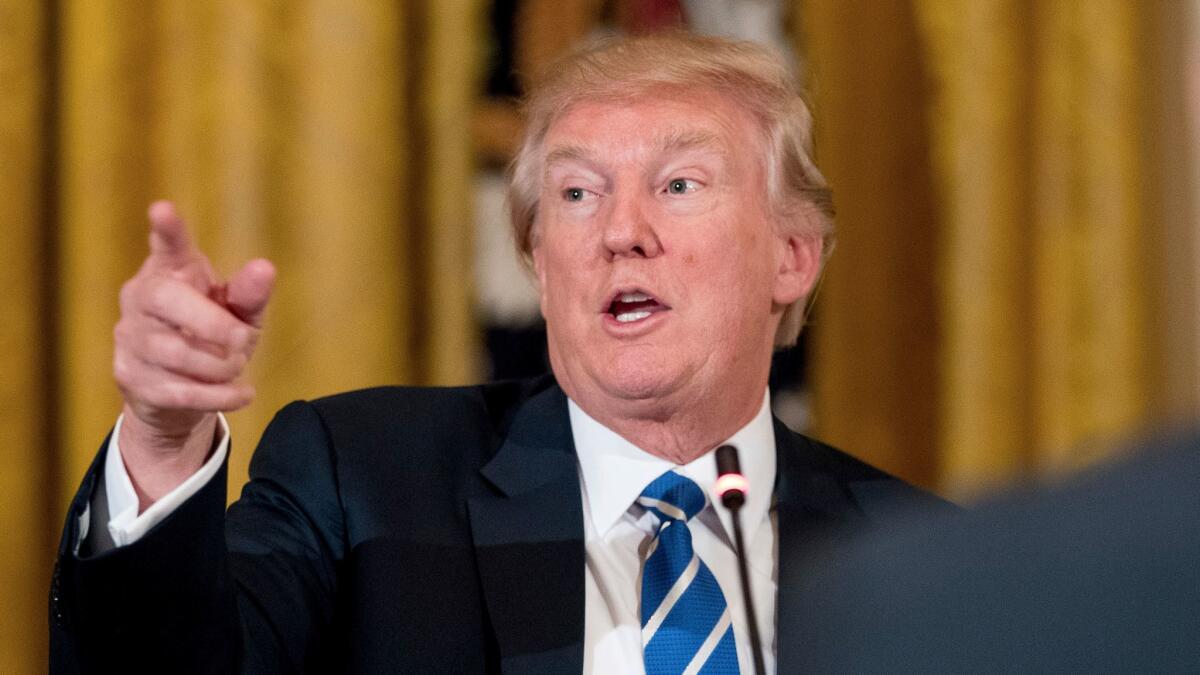Editorial: Trump sells a bill of goods to Obamacare ‘victims’

Not long after the Congressional Budget Office reported Monday that the House GOP leadership’s proposal to “repeal and replace” Obamacare would nearly double the number of uninsured Americans, President Trump held a meeting in the White House with about a dozen people he described as “victims” of President Obama’s 2010 healthcare law.
It was a scene reminiscent of the photo opportunities arranged by Democrats when they were trying to drum up support for their proposed healthcare reforms early in President Obama’s first term. But instead of showcasing people with life-threatening conditions who couldn’t get coverage or had it capriciously rescinded after they’d gotten sick, as the Democrats did, Trump spotlighted people, many of them healthy, whose complaint is that they are paying a lot more for insurance than they used to.
That’s a legitimate complaint, and Congress certainly should address it. But high premiums are not the only issue for policymakers as they work to make the healthcare system more efficient and affordable for all Americans. And what Trump apparently didn’t tell his visitors was that the House GOP bill that he’s pushing wouldn’t solve their problems. It might even make them worse.
That’s because the bill (dubbed the American Health Care Act) aims to help the healthy and the wealthy at the expense of everyone else. In addition to eliminating most of the taxes that paid for the 2010 law — a change that would save the highest-income Americans more than $300 billion over 10 years — the measure would encourage insurers to cut premiums by covering a smaller percentage of their customers’ medical bills.The tradeoff for those lower premiums is higher deductibles, copays and other out-of-pocket costs — the very things that many of Trump’s guests complained about.
And to think Republicans called President Obama divisive.
For healthy people who don’t need insurance, the House bill may look like a godsend. They would no longer face annual penalties for going uninsured; instead, they’d just have to pay a 30% surcharge for a year once they needed treatment and signed up for a policy. Sweet deal! And astronomical deductibles and co-payments would be no problem as long as they limited their doctor visits to the co-pay-free annual check-up.
But the group assembled by Trump included a number of people who actually do need care. For example, there was the Colorado rancher with an autistic son, the Texas doctor whose wife is a breast cancer survivor, and a Utah county commissioner with an ailing wife and child. The House bill would help some middle-income families with new tax credits that would cut a few thousand dollars off the cost of coverage. But the overall effect of the bill would be to herd people who need more serious care into more expensive plans shunned by healthy individuals, driving costs even higher.
In other words, the House bill doesn’t try to fix the problems on display in some states’ Obamacare markets — the higher-than-expected healthcare costs and the smaller-than-expected number of healthy people enrolled — that have led to higher premiums and fewer insurers offering policies. Instead, it would tell insurers to go back to what they did before the 2010 law took effect: Design policies to appeal to the young and healthy, while setting prices for truly comprehensive plans so high that sicker and riskier customers can’t afford them.
It also would shift federal subsidies and pricing rules to help younger and better-off consumers while putting coverage out of reach for millions of lower-income Americans. It would be particularly hard on low-wage workers whom the 2010 law made eligible for Medicaid; they would gradually lose that eligibility after 2020 under the GOP plan.
And to think Republicans called President Obama divisive. The House leadership proposal is a cynical exercise in splitting the interests of the healthy from those who need treatment, and the middle and upper classes from the poor.
The CBO report projected that 14 million additional people would go without insurance in 2018 — some by choice, but many because they could no longer afford it — if the American Health Care Act became law, with the number rising to 24 million in 2026. That’s more people than you’ll find in Idaho, Wyoming, the Dakotas, Montana, Nevada, New Mexico, Nebraska, Kansas, Arkansas, Mississippi, West Virginia, Delaware, Rhode Island, Vermont, New Hampshire, Maine, Alaska and Hawaii … combined.
“If we’re allowed to do what we want to do,” Trump told his guests Monday, “it will get better. Much better.” He didn’t say for whom.
Of course, had Republicans not worked actively to undermine Obamacare — rejecting a government-run fallback insurance plan, reneging on pledges to help insurers cover their losses in the program’s first few years, refusing to expand Medicaid in almost half the states, impeding efforts to sign up people for coverage — the problems aired at the White House Monday might never have emerged. They did, and Congress should address them. But that means actually slowing the growth of healthcare costs and helping more people afford the coverage they need, neither of which the House proposal even attempts to do.
Follow the Opinion section on Twitter @latimesopinionand Facebook
MORE FROM OPINION
The Trump administration’s bogus claim about Obamacare and workers’ comp
More to Read
A cure for the common opinion
Get thought-provoking perspectives with our weekly newsletter.
You may occasionally receive promotional content from the Los Angeles Times.










